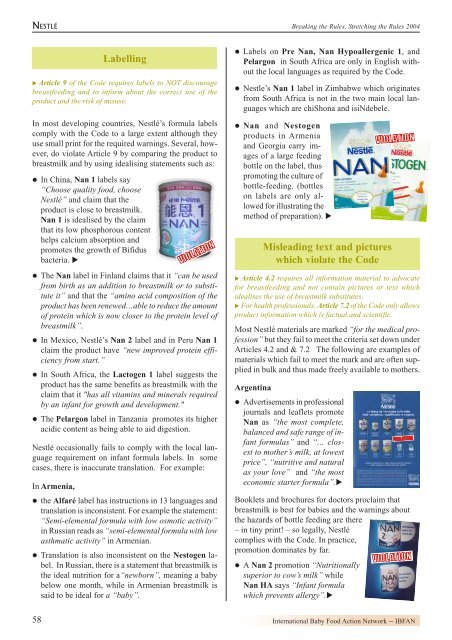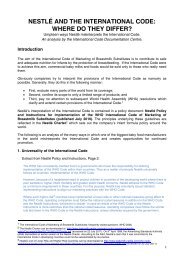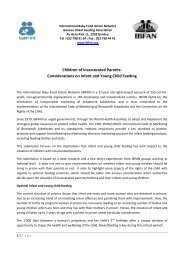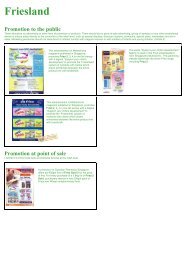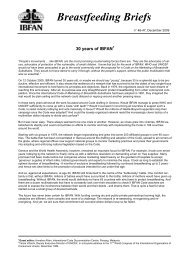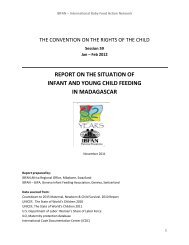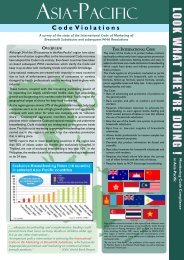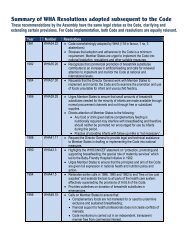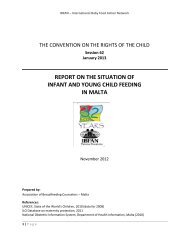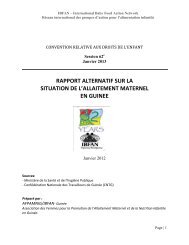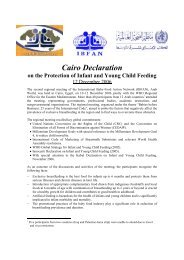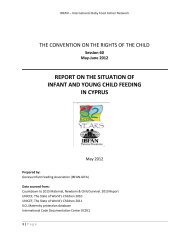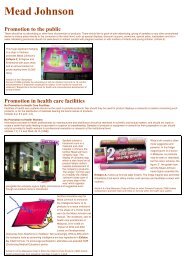Create successful ePaper yourself
Turn your PDF publications into a flip-book with our unique Google optimized e-Paper software.
NESTLÉ<br />
Labelling<br />
� Article 9 of the Code requires labels to NOT discourage<br />
breastfeeding and to inform about the correct use of the<br />
product and the risk of misuse.<br />
In most developing countries, Nestlé’s formula labels<br />
comply with the Code to a large extent although they<br />
use small print for the required warnings. Several, however,<br />
do violate Article 9 by comparing the product to<br />
breastmilk and by using idealising statements such as:<br />
� In China, Nan 1 labels say<br />
“Choose quality food, choose<br />
Nestlé” and claim that the<br />
product is close to breastmilk.<br />
Nan 1 is idealised by the claim<br />
that its low phosphorous content<br />
helps calcium absorption and<br />
promotes the growth of Bifidus<br />
bacteria. �<br />
� The Nan label in Finland claims that it “can be used<br />
from birth as an addition to breastmilk or to substitute<br />
it” and that the “amino acid composition of the<br />
product has been renewed…able to reduce the amount<br />
of protein which is now closer to the protein level of<br />
breastmilk”.<br />
� In Mexico, Nestlé’s Nan 2 label and in Peru Nan 1<br />
claim the product have “new improved protein efficiency<br />
from start.”<br />
� In South Africa, the Lactogen 1 label suggests the<br />
product has the same benefits as breastmilk with the<br />
claim that it "has all vitamins and minerals required<br />
by an infant for growth and development."<br />
� The Pelargon label in Tanzania promotes its higher<br />
acidic content as being able to aid digestion.<br />
Nestlé occasionally fails to comply with the local language<br />
requirement on infant formula labels. In some<br />
cases, there is inaccurate translation. For example:<br />
In Armenia,<br />
� the Alfaré label has instructions in 13 languages and<br />
translation is inconsistent. For example the statement:<br />
“Semi-elemental formula with low osmotic activity”<br />
in Russian reads as “semi-elemental formula with low<br />
asthmatic activity” in Armenian.<br />
� Translation is also inconsistent on the Nestogen label.<br />
In Russian, there is a statement that breastmilk is<br />
the ideal nutrition for a“newborn”, meaning a baby<br />
below one month, while in Armenian breastmilk is<br />
said to be ideal for a “baby”.<br />
Breaking the Rules, Stretching the Rules 2004<br />
� Labels on Pre Nan, Nan Hypoallergenic 1, and<br />
Pelargon in South Africa are only in English without<br />
the local languages as required by the Code.<br />
� Nestle’s Nan 1 label in Zimbabwe which originates<br />
from South Africa is not in the two main local languages<br />
which are chiShona and isiNdebele.<br />
� Nan and Nestogen<br />
products in Armenia<br />
and Georgia carry images<br />
of a large feeding<br />
bottle on the label, thus<br />
promoting the culture of<br />
bottle-feeding. (bottles<br />
on labels are only allowed<br />
for illustrating the<br />
method of preparation). �<br />
Misleading text and pictures<br />
which violate the Code<br />
� Article 4.2 requires all information material to advocate<br />
for breastfeeding and not contain pictures or text which<br />
idealises the use of breastmilk substitutes.<br />
� For health professionals, Article 7.2 of the Code only allows<br />
product information which is factual and scientific.<br />
Most Nestlé materials are marked “for the medical profession”<br />
but they fail to meet the criteria set down under<br />
Articles 4.2 and & 7.2 The following are examples of<br />
materials which fail to meet the mark and are often supplied<br />
in bulk and thus made freely available to mothers.<br />
Argentina<br />
� Advertisements in professional<br />
journals and leaflets promote<br />
Nan as “the most complete,<br />
balanced and safe range of infant<br />
formulas” and “… closest<br />
to mother’s milk, at lowest<br />
price”, “nutritive and natural<br />
as your love” and “the most<br />
economic starter formula”.�<br />
Booklets and brochures for doctors proclaim that<br />
breastmilk is best for babies and the warnings about<br />
the hazards of bottle feeding are there<br />
– in tiny print! – so legally, Nestlé<br />
complies with the Code. In practice,<br />
promotion dominates by far.<br />
� A Nan 2 promotion “Nutritionally<br />
superior to cow’s milk” while<br />
Nan HA says “Infant formula<br />
which prevents allergy”.�<br />
58 International Baby Food Action Network -- <strong>IBFAN</strong>


